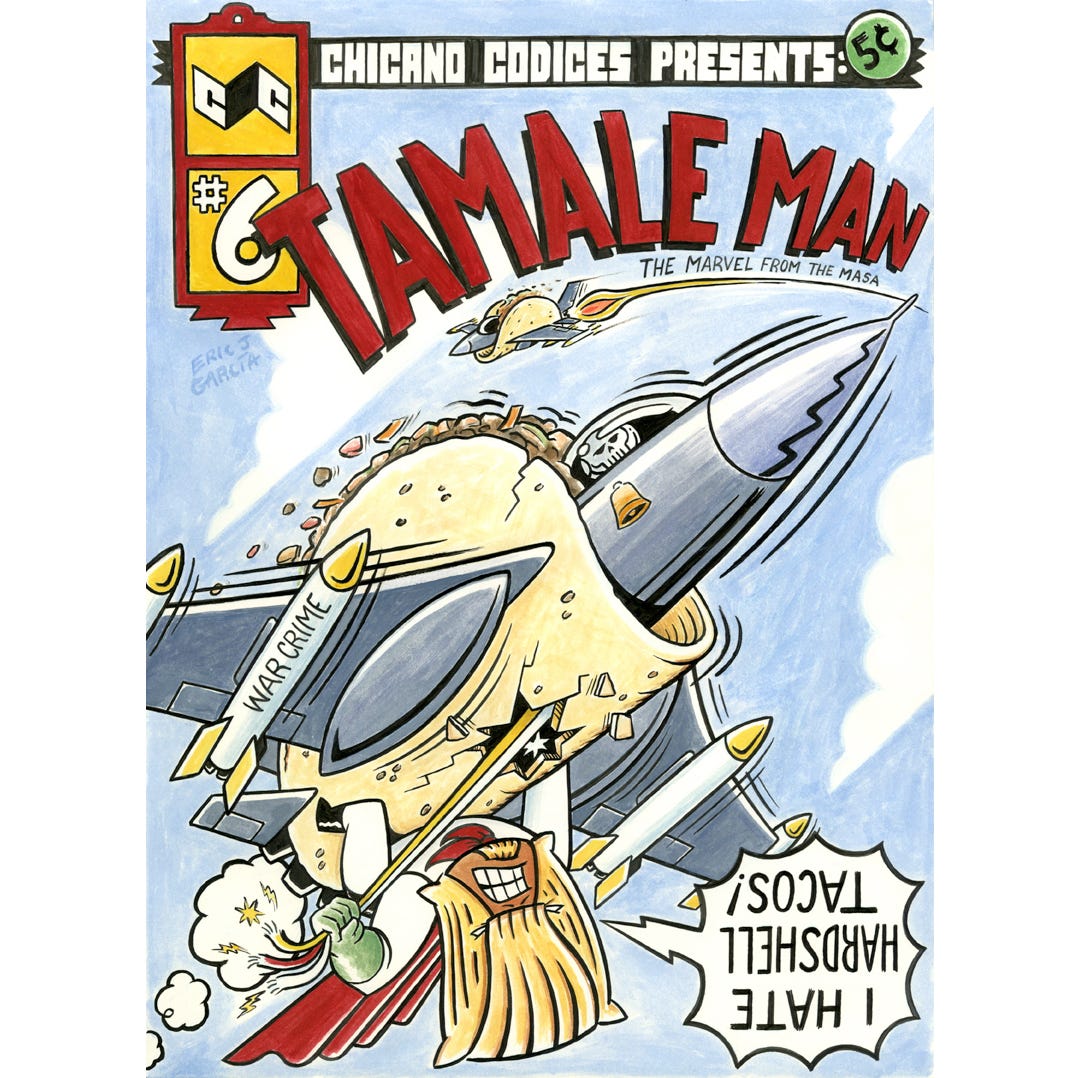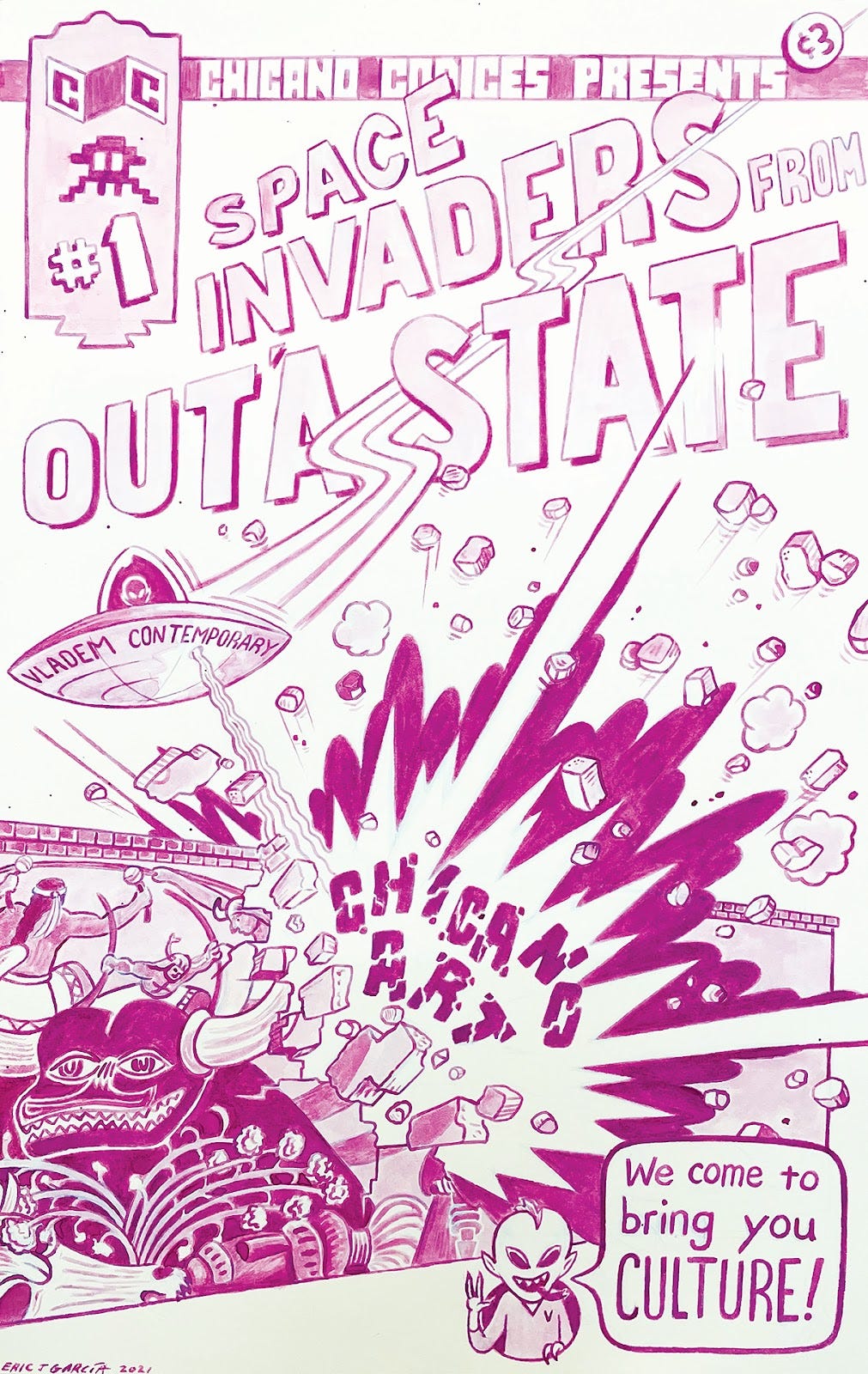An Interview with Eric García
"Teaching is integral to my work. I love teaching people new things. I love unveiling hidden histories."
I (Amaris) have been a big fan of Eric García’s work since I was an undergraduate at the University of New Mexico, studying cultural anthropology and Latin American studies. Eric’s political cartoons in the student newspaper, the Daily Lobo, were always right on the nose with the histories I was learning about in the classroom. So, I was delighted when I bumped into him at the Southwest Popular American Culture Association conference and he agreed to this interview for Autobiographix.
Describe your comics journey—how did you get into making comics?
I have always been drawing since I can remember but I think comic books were one of my first introductions to Art. And I do mean Art with capital “A.” Sometimes I go to museum of contemporary art and I’m asking myself “what the hell am I looking at?!” Then I go to the comic book store and then I feel at home and say to myself “ah, here’s the art.”
My first comic books were a stack of old ratty leftovers from my older brother. Even before I could read, I was delving into the pages and understanding the narrative, thanks to the magic of sequential imagery which uses visuals to do the heavy lifting in telling the story. The “Funny Pages” from the Sunday morning paper was another source of inspiration and of course the political cartoon that was tucked away admits all those words of the editorial section. Even though I didn’t quite understand the socio-political commentary, I found the illustrations intriguing.
I think my very first political cartoon was a challenge/favor from my activist brother who needed a cartoon for an issue during his college years. And then during my enlistment in the Air Force, I found myself creating lots of caricatures and satire, making fun of the officers and the jobs they made us do. So when my enlistment finally ended I used the GI Bill and went to college.
At the University of New Mexico I saw a job opening for a political cartoonist for the school newspaper, the Daily Lobo. I figured I had some experience so I applied and I got the job. My editor liked my work but told me I needed a name for my one panel cartoon series. At the time I was taking Chicano studies classes where I had heard of a radical underground newspaper during the Chicano movement at Highlands University in Las Vegas, NM, called “El Machete.” So, I decided to name my series after this, but mine was going to be the illustrated version. I learned later on that this Highland paper was modeled off the communist El Machete paper started by Mexican Muralists Diego Rivera and David Afaro Siqueros in Mexico City.
After I graduated I worked for the Albuquerque entertainment magazine the Alibi for a couple of years before it closed shop. I have been publishing ever since wherever I can. I was never able to break into syndication but this has allowed me to be super flexible with my work and I never had to worry about censorship. After living out of state for over a decade I just recently moved back and I have luckily started publishing locally again through a relatively new paper called the Paper. Aside from political cartoons I also create longer format comic strips through my Chicano Codices label, which includes my heroes like Tamale Man: The Marvel from the Masa.
How did you develop your comics voice?
I was always fascinated by the comic book cover. The cover itself was an amazing work of art and design, that would become my template for how I compose a majority of my work. The cover is an eye-catching, dramatic single image that is made to entice you to buy and dive into the story. Using an array of text the cover details the issue number, the comic brand, the characters of the comic, the artists and hints at the story inside; the cover is jammed packed with information. I have made many paintings, prints and drawings using this comic book cover template. I also use it for structuring my political cartoons: a dramatic single image that does the heavy lifting of telling the story, detailed by minimal text to entice the viewer to want to know more about the issue I am presenting.
I would say my style as a political cartoonist is old fashioned. I still only use black and white. Modern printing and especially the web allows more possibilities for color, but I grew up seeing editorials only in black and white. The Hernandez Bros. were an early inspiration during high school and their ingenuity of the basic black line with strong shadows showed me that you can do so much with so little. Their style is also a nod to an earlier comic style of Archie comic books, so my style is definitely wrapped up with an earlier era.
What are some of the joys and challenges of making political cartoons?
Teaching is integral to my work. I love teaching people new things. I love unveiling hidden histories. I love spotlighting issues that have been overlooked or simply taking a new perspective on an issue. My comics, editorial cartoons and murals are all teaching tools. The challenge for me is visualizing complicated histories and political issues. In longer formats like a comic strip or comic book, there is more room to lay out a narrative. Usually any great tale has a beginning/challenge, a climax and a conclusion/resolution. This can be done easily with written text and can be achieved visually with multiple visualized panels as in a comic strip, but try to compact the story into one defining visual. Which single part of the story is best/important to depict? How can one image stand for the grand narrative? How can this single image illustrate a complex narrative but be simple enough to be understood? This is the challenge I have each week when I’m composing a political cartoon. And then once the cartoon is created, finding outlets for them to be seen is another challenge. I have always had a hard time finding newspapers to carry my cartoons. My cartoons have always been seen as too political (whatever that means) or too critical of our nation, which makes newspapers wary to print.
Are you working on something now?
I’m always working on something. I have long term projects like the origin story of Tamale Man, which I created almost two years ago and will debut in the anthology: Cocinas to Lucha Libre Ringsides, this fall. Cocinas to Lucha Libre Ringsides, is the second anthology of Latinx comic book creators that Processor Frederick Aldama,(the leading authority of Latinx comics) and has organized. His first anthology was called Tales from La Vida, and was created to highlight the diversity and talent of Latinx creators. Another anthology that I will be a part of, is the Chamisa Journal of Literary, Performance and Visual Arts of the Greater Southwest. The debut for this journal is on Thursday, May 2 at the University of New Mexico. The comic book cover illustration that is printed in the Chamisa journal was drawn with a special ink I was experimenting with, made from Tinta de Tuna or prickly pear fruit. The comic book cover depicts aliens coming to New Mexico to bring us culture, which is a sarcastic take on the New Mexico Contemporary Art museum’s destruction of an historic Chicano mural. As for short term projects, I try to make time to publish a cartoon each week while chasing my three year-old around.
Eric J. García uses history and a graphic style to create political art that confronts our understanding of the present. Garcia, received his BFA with a minor in Chicano studies from the University of New Mexico, and earned his MFA from the School of the Art Institute of Chicago. A versatile artist, when he’s not making comic strips, or murals or printmaking, or sculptural installations, you can usually find him inking his controversial political cartoon series, EL Machete Illustrated.
Check out more of Eric’s work:
Drawing On Anger: Portraits of U.S. Hypocrisy
Tales from la Vida: A Latinx Comics Anthology
Tumblr: https://elmacheteillustrated.tumblr.com/
Instagram: https://www.instagram.com/elmacheteillustrated/?hl=en









